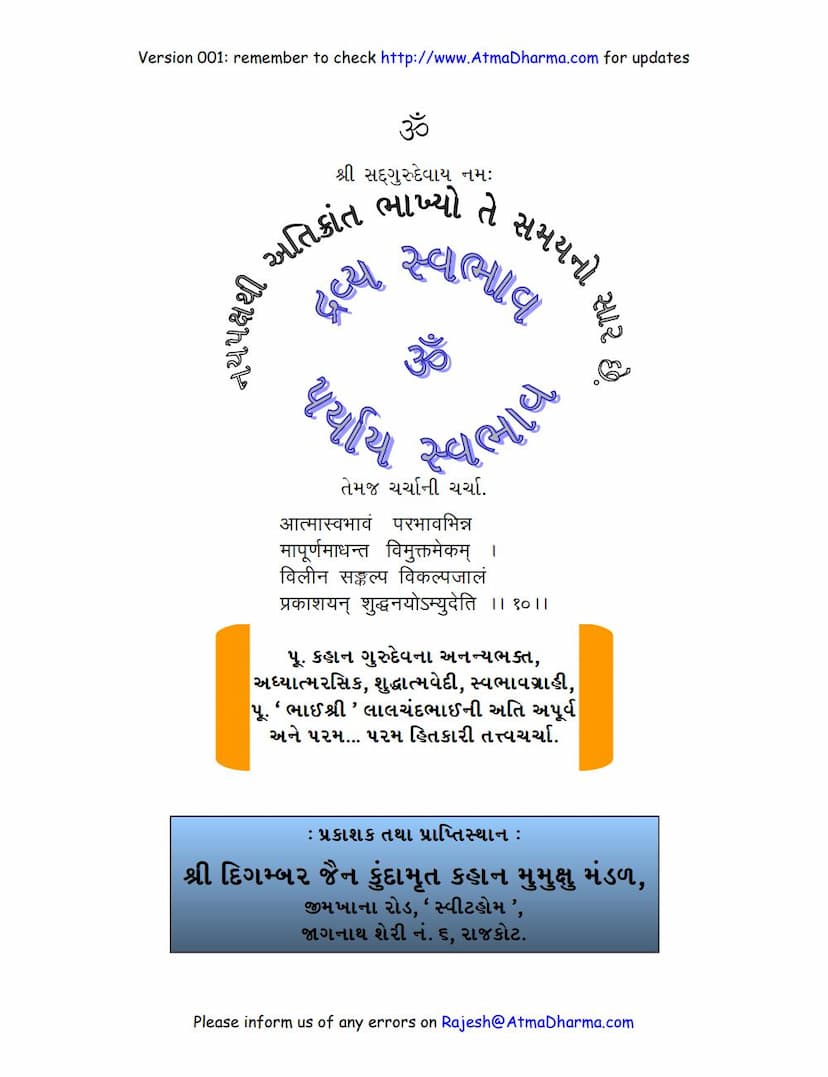Dravya Svabhaav Paryaya Svabhaav
Added to library: September 1, 2025

Summary
This Jain text, titled "Dravya Svabhaav Paryaya Svabhaav" (Essence of Substance and Essence of States) by Lalchandra Pandit, published by Digambar Jain Kundamrut Kahan, delves deeply into the fundamental concepts of Jain philosophy, particularly focusing on the nature of reality through the lens of substance (Dravya) and state (Paryaya). The text emphasizes the importance of understanding the inherent nature (Svabhaav) of both the substance and its states to achieve liberation.
Here's a comprehensive summary based on the provided pages:
Core Concepts:
- Dravya (Substance): The underlying, unchanging reality of a thing. It is eternal and possesses qualities (Guna) and states (Paryaya). The text emphasizes that the substance itself is not directly apprehended by sensory knowledge or intellectual reasoning but is understood through its manifestations.
- Paryaya (State/Modification): The changing, transient states or modifications that a substance undergoes. These are momentary and are the modes through which the substance manifests.
- Svabhaav (Inherent Nature): The text highlights the inherent nature of both the substance and its states. Understanding the true, untainted, and essential nature of the soul (Atma) as the substance and its pure states is crucial for spiritual progress.
- Nayas (Standpoints/Perspectives): A significant portion of the text discusses the role and limitations of various nayās (standpoints or perspectives) in understanding reality, particularly Nischaya Naya (Ultimate/Realist Standpoint) and Vyavahara Naya (Conventional/Practical Standpoint). The author, guided by the teachings of Gurudev Shri Kanji Swami and supported by the profound insights of Pujya Bhai Shri Lalchandbhai, stresses that while nayās are essential tools for initial understanding and intellectual grasp, they are ultimately part of the conceptual realm and not the direct experience of the soul.
Key Arguments and Teachings:
- The Supremacy of Svabhaav: The central theme is that true understanding and experience of the soul (Atma) come from directly realizing its inherent nature (Svabhaav) rather than getting entangled in the intellectual constructs of nayās. While nayās can point towards the truth, they are ultimately conceptual and can become obstacles if clung to.
- Beyond Nayas: The text repeatedly emphasizes that the ultimate reality of the soul (Atma) is nayātīta (beyond nayās) and pakṣātīta (beyond standpoints). The goal is to transcend all conceptual frameworks and directly experience the soul's pure, unadulterated nature.
- The Limitations of Nayas: The author details how getting stuck in nayās leads to intellectual debates, pride in knowledge, and ultimately prevents the direct experience of the soul. Nischaya Naya, while closer to the truth, is still a conceptual construct and must also be transcended. The true path is to realize the Svabhaav directly.
- The Role of Pujya Bhai Shri Lalchandbhai: The text is presented as a compilation of the profound spiritual discussions of Pujya Bhai Shri Lalchandbhai, a devoted follower of Gurudev Shri Kanji Swami. His teachings are described as distilling the essence of Jain scriptures, particularly Samaysara, and presenting them in a way that leads to direct experience.
- The Goal of Experience: The ultimate aim is Ātmānubhūti (Self-realization or direct experience of the soul). The discussions are geared towards guiding the reader beyond intellectual understanding of nayās and towards this direct, experiential knowledge.
- Critique of Intellectualism: The text subtly critiques those who become engrossed in the intellectual understanding of Jain philosophy through nayās without progressing to direct experience. Such knowledge, while perhaps vast, is ultimately deemed insufficient for liberation.
- The Path to Liberation: The path described involves first understanding the soul through the lens of nayās (as a necessary initial step) and then transcending these nayās to realize the Svabhaav. This involves letting go of conceptual attachments and resting in the pure, inherent nature of the soul.
- Importance of Gurudev Shri Kanji Swami: The teachings are deeply rooted in the tradition of Gurudev Shri Kanji Swami, who is credited with reviving and propagating the pure spiritual path in the current era. Pujya Bhai Shri Lalchandbhai is presented as a key disciple who elucidated these teachings further.
- Practical Guidance: The discussions aim to provide a practical method for spiritual seekers to overcome the limitations of conceptual knowledge and achieve direct experience of the soul's liberated state. The emphasis is on the "how-to" of transcending intellectualism to reach the ultimate experience.
- Dravya and Paryaya as Svabhaav: The book explores how understanding Dravya (substance) in its inherent nature and Paryaya (state) in its inherent nature is the key. The substance is understood as the unchanging reality, and its states are its modifications. The goal is to realize the pure, unchanging substance through its pure states, or rather, the pure nature of both simultaneously.
In essence, "Dravya Svabhaav Paryaya Svabhaav" is a guide to spiritual liberation within Jainism, emphasizing the direct experience of the soul's inherent nature by moving beyond the intellectual grasp of philosophical concepts (nayās) and cultural or ritualistic practices. It highlights the teachings of revered Jain monks and saints, particularly Pujya Bhai Shri Lalchandbhai, in their endeavor to guide spiritual aspirants towards self-realization.